
|
The Society of Folk Dance Historians (SFDH)
Folk Dance Decline and Resurrection
[
Home |
About |
Encyclopedia | CLICK AN IMAGE TO ENLARGE |
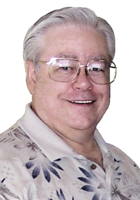
|
Why the decline in Recreational International Folk Dance?
It is difficult to avoid the conclusion that Recreational International Folk Dance is in a decline. The debate comes in as to whether it is dying or just in a natural trough and in whether the cause lies in the inevitable rise and fall of dance popularities or in the behavior of the participants.
Articles in recent folk dance periodicals suggest the demise of international folk dancing. Some blame splinter groups. Some blame shyness. Some blame intropection. They're all correct! No community can survive on a basis of self-gratification.
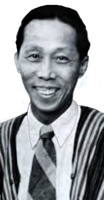 Song Chang said in 1948 that if the movement is to succeed in the right channel, we would have to make it easier for people to join and stay in folk dancing. The general impression today is that prospective folk dancers are afraid even to come in and try to learn to dance. Curiously enough, dancing itself has been one of the may barriers. Many who have come in have been finding it difficult to keep up due to the too large repertoire of dances. The whole scheme challenges their courage, abilities, stamina, and patience. They feel thay have been burdened with the problem of forever learning. How then should we keep from getting discouraged to a point of quitting?
Song Chang said in 1948 that if the movement is to succeed in the right channel, we would have to make it easier for people to join and stay in folk dancing. The general impression today is that prospective folk dancers are afraid even to come in and try to learn to dance. Curiously enough, dancing itself has been one of the may barriers. Many who have come in have been finding it difficult to keep up due to the too large repertoire of dances. The whole scheme challenges their courage, abilities, stamina, and patience. They feel thay have been burdened with the problem of forever learning. How then should we keep from getting discouraged to a point of quitting?
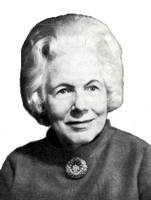 Sarah Gerturde Knott mourned in 1955 that there's not a state in the Union where folk songs, dances, legends, and other folklore of the inherited kinds are not passing. A new way of life is sounding the death knell in spite of the widespread interest in the newly learned, standardized folk dances and songs recently taken from books. Those who look beneath the surface can see the influence of three kinds of present-day teachers. All are important, but we believe that one is more important then the other two as far as the future is concerned. These three kinds of teachers are:
Sarah Gerturde Knott mourned in 1955 that there's not a state in the Union where folk songs, dances, legends, and other folklore of the inherited kinds are not passing. A new way of life is sounding the death knell in spite of the widespread interest in the newly learned, standardized folk dances and songs recently taken from books. Those who look beneath the surface can see the influence of three kinds of present-day teachers. All are important, but we believe that one is more important then the other two as far as the future is concerned. These three kinds of teachers are:
- The "Purist" believes that the traditional expressions should not be touched unless it is possible to present them in their original state – what he considers the "genuinely authentic form."
- The "For Fun Only" singers and dancers are those who have no regard for folk expression except to meet the immediate need for fun. Often, this kind of teacher has no qualms whatever about changing folk dances or songs. The majority of this class usually has not inherited any kind of traditional legacy, and has no special knowledge of the past or potential future value of any phase of folklore.
- The "Middle Ground" teacher, who finds the most real and lasting satisfaction by following the traditional in form, substance, and spirit, allowing for the inevitable changes that unconsciously come about to help make traditional expressions better meet the needs of the present.
See Sarah's article Three Kinds of Teachers: Which Shall We Follow? on this site!
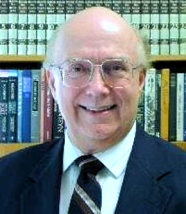 Graham Hempel said in 1988, "I see the graying of folk dance clubs. The median age is getting older and older and I am fearful folk dance is dying out. In this 'ME generation', all the folk art forms are falling by the wayside."
Graham Hempel said in 1988, "I see the graying of folk dance clubs. The median age is getting older and older and I am fearful folk dance is dying out. In this 'ME generation', all the folk art forms are falling by the wayside."
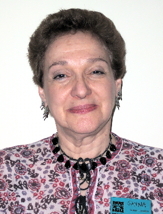 Sanna Longden stated in 1994 that there has been a big decline in recreational International Folk Dance in general all over the world – it is a subject that all endlessly debate.
Sanna Longden stated in 1994 that there has been a big decline in recreational International Folk Dance in general all over the world – it is a subject that all endlessly debate.
Recreational International Folk Dance groups are having a tough time surviving in the 1990s. If these grass roots organizations wither and die, the health of our performing ensembles, international festivals, academic programs, regional camps, and ethnic workshops is also endangered: Recreational dancers are the audience, the participators, the target market, the membership – the foundation – of most other folk dance activities.
A basic reason for the decline in interest and attendance is that many recreational groups have continued to carry on in the same ways they did during the golden years of folk dance, in spite of changes in society and people's leisure needs. Most other social dance forms are a better fit for our contemporary culture, particularly for younger people – quickly learned patterns, familiar rhythms, do-you-own-thing choreographies, continuous partner changing, and often great live music. The idea of working for weeks to learn a seven-part, uneven-meter Balkan dance choreography done to a scratchy recording does not attract people who just want to do some dancing, especially if the only part of another person they get to hold is the belt!
It is clear that change is necessary if recreational groups are going to regain any vitality.
See Sanna's article Let's Bring Folks Back to Recreational Folk Dance on this site!
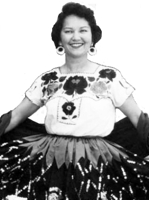 Nelda Drury implicates the loss of college folk dance courses resulting from budget cuts. Without that influx of young people, the recreational International Folk Dance movement is aging, repelling yet more young people.
Nelda Drury implicates the loss of college folk dance courses resulting from budget cuts. Without that influx of young people, the recreational International Folk Dance movement is aging, repelling yet more young people.
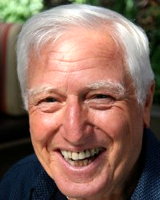 Lou Pechi notes that some folk dance teachers and choreographers in order to make dances interesting and challenging, keep adding different step patterns into a single dance. One or two patterns to a dance are okay, but six or seven? Who can remember them all, let alone the order they are supposed to be executed. Unless there is a leader, who calls out the required pattern; Lou can handle no more than two step patterns per dance.
Lou Pechi notes that some folk dance teachers and choreographers in order to make dances interesting and challenging, keep adding different step patterns into a single dance. One or two patterns to a dance are okay, but six or seven? Who can remember them all, let alone the order they are supposed to be executed. Unless there is a leader, who calls out the required pattern; Lou can handle no more than two step patterns per dance.
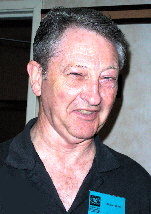 Richard Duree says no wonder recreational International Folk Dance has lost its bloom. It aged without maturing. It placed quantity ahead of quality. It placed choreography ahead of ethnology. It placed memorization ahead of technique. It placed regurgitation ahead of improvisation.
Richard Duree says no wonder recreational International Folk Dance has lost its bloom. It aged without maturing. It placed quantity ahead of quality. It placed choreography ahead of ethnology. It placed memorization ahead of technique. It placed regurgitation ahead of improvisation.
We all know, or should know, that our aging folk dance community will not survive us without new members. It's been said that the last folk dancer is now a senior citizen – probably true. A famous folk dance teacher even said that he doesn't care what happens to the folk dance community after its gone. He might not, but I do. And so should we all.
But on too many occasions I've seen visitors treated in ways that ensure they will not return. They have been ignored as though they were invisible. They have been arrogantly told to "follow along behind the line." They have even been obviously resented. They have been dragged into what a folk dancer may think of as a "simple" dance, but to a beginner is a confusing and meaningless mix of steps, changes of direction, turns, and leg gestures that guarantee a frustrating and unsuccessful experience. Interesting information about the dance, such as where it comes from, that might intrigue a visitor is never shared. After two or three of those, the most I've ever seen shared with a visitor, it's no wonder they don't return. They have been intimidated, embarrassed, overwhelmed, discouraged, disappointed, and unimpressed.
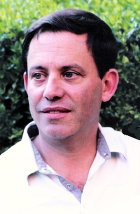 Barry Glass declares that when he started recreational International Folk Dance, one could look at the repertoire of international dances and reasonably hope to have the majority under control within a year. Then came the many years of professional teachers who were pushed to create new dances by the score to satisfy the guidelines of various festivals, clubs, and especially folk dance camps. A fallout of this process is to have created a vast repertoire of dances where only a computer can retain them all. "If I came to visit a folk dance club as a beginner today, I would last two seconds before I left the 'hostile' environment for the relaxation and fun of the contra dance."
Barry Glass declares that when he started recreational International Folk Dance, one could look at the repertoire of international dances and reasonably hope to have the majority under control within a year. Then came the many years of professional teachers who were pushed to create new dances by the score to satisfy the guidelines of various festivals, clubs, and especially folk dance camps. A fallout of this process is to have created a vast repertoire of dances where only a computer can retain them all. "If I came to visit a folk dance club as a beginner today, I would last two seconds before I left the 'hostile' environment for the relaxation and fun of the contra dance."
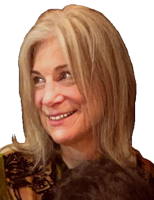
 Mitch and Laurie Allen in 1984 say pinpointing the problem is not difficult. There are fewer people dancing now than there were a decade ago. They are older – many will soon be too old or ill to actively participate. The only existing structure in Southern California, the Folk Dance Federation of California South, includes less than half of the people who actually folk dance on a regular basis. Many dance clubs, classes, or groups are isolated from the general folk dance community. Folk dancing is a remarkably poor activity, with no cash reserves for improving equipment or purchase equipment, records, publicity, costumes, or a permanent home.
Mitch and Laurie Allen in 1984 say pinpointing the problem is not difficult. There are fewer people dancing now than there were a decade ago. They are older – many will soon be too old or ill to actively participate. The only existing structure in Southern California, the Folk Dance Federation of California South, includes less than half of the people who actually folk dance on a regular basis. Many dance clubs, classes, or groups are isolated from the general folk dance community. Folk dancing is a remarkably poor activity, with no cash reserves for improving equipment or purchase equipment, records, publicity, costumes, or a permanent home.
As an activity of primarily volunteers, there is a dearth of manpower to keep the activity growing. Even the few who try to make a living at it need to work elsewhere to supplement their income. There is an absence of new blood, particularly young new blood, to re-infuse the movement. Folk dancing is turning into a dinosaur.
See the Allen's article Folk Dance Revival on this site!
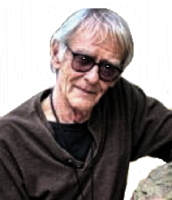 David Henry in 1997 revealed that the recreational International Folk Dance scene today is quite different from the scene of 40 years ago. Then, going folk dancing meant that you might do a Balkan dance followed by an Israeli dance followed by a Hungarian dance followed by a Scandinavian dance followed by a Contra. Today, such "international" groups have diminished in number, and part of the reason is that today we have specialized groups doing only Balkan, only Contra, only Hungarian, only Israeli, and only Scandinavian dances. That's great for those who love those kinds of dancing, but it's been terrible for the "international" dance scene.
David Henry in 1997 revealed that the recreational International Folk Dance scene today is quite different from the scene of 40 years ago. Then, going folk dancing meant that you might do a Balkan dance followed by an Israeli dance followed by a Hungarian dance followed by a Scandinavian dance followed by a Contra. Today, such "international" groups have diminished in number, and part of the reason is that today we have specialized groups doing only Balkan, only Contra, only Hungarian, only Israeli, and only Scandinavian dances. That's great for those who love those kinds of dancing, but it's been terrible for the "international" dance scene.
See David's article Folk Dance Demise on this site!
 Ron Houston, in 2013, blames local leaders who isolate their groups from the larger recreational International Folk Dance world, seeking to protect their share of dwindling attendance. He also says:
Ron Houston, in 2013, blames local leaders who isolate their groups from the larger recreational International Folk Dance world, seeking to protect their share of dwindling attendance. He also says:
- National organizations meet, but they discuss revenue, rather than engage in dance.
- Local groups cover lack of research with the isolationist "We dance it differently in our village."
- Local leaders isolate their groups from the larger RIFD world, seeking to protect their share of the dwindling attendance.
- Local musicians strive to be more authentic than native musicians, an example of Umberto Eco's 'hyper-reality' (Travels in Hyperreality, 1986).
- Beginning dancers seek multiculturalism but find (and must join) cliques.
- Second-year dancers seek recognition on the stage.
- Third-year dancers seek recognition as teachers.
- Fourth-year dancers seek recognition as master teachers!
If you want international folk dancing to survive, try dancing beyond yourself. Think of others when you dance. Help with the group you attend. Give to the countries you visit, instead of only taking.
See Ron's article Reviving Folk Dance on this site!
 Yves Moreau remembers that people are still in the stage of collecting dances. The first thing on their minds are to come and ask him, 'What are you going to teach?' And they only go to camp to bring back a hundred new dances. It's unfortunate. A lot of people are into this: everyone has their own little ego trips, because when people go home, they're the ones. People there don't know Yves Moreau; to them it's John Doe who's the expert. So many dances have been taught. Somebody doesn't even have time to digest the dances he's learned, and he finds himself at an institute with ANOTHER syllabus under his arm, trying to figure out twenty more. And I feel partly guilty, because when teaching a workshop, I'm adding more to the list. I think there's something like 6,000 dances that have been taught in North America. 6,000! including all the camps and workshops everywhere. How many do we know? and how many can we possibly keep? Unfortunately, a lot of dances have been taught strictly so teachers could make a living; they have to keep introducing new material.
Yves Moreau remembers that people are still in the stage of collecting dances. The first thing on their minds are to come and ask him, 'What are you going to teach?' And they only go to camp to bring back a hundred new dances. It's unfortunate. A lot of people are into this: everyone has their own little ego trips, because when people go home, they're the ones. People there don't know Yves Moreau; to them it's John Doe who's the expert. So many dances have been taught. Somebody doesn't even have time to digest the dances he's learned, and he finds himself at an institute with ANOTHER syllabus under his arm, trying to figure out twenty more. And I feel partly guilty, because when teaching a workshop, I'm adding more to the list. I think there's something like 6,000 dances that have been taught in North America. 6,000! including all the camps and workshops everywhere. How many do we know? and how many can we possibly keep? Unfortunately, a lot of dances have been taught strictly so teachers could make a living; they have to keep introducing new material.
 Loui Tucker relates that one drawback today that didn't exist 40-plus years ago is the age difference between the young people potentially joining existing adult dance groups and the age of the folks already in those groups. For example, when I joined at 21, there were plenty of other young people and the experienced dancers were in their 30s and 40s – a gap of 10 or 20 years. As it stands now, if a young dancer just out of college, who was used to dancing with dancers about the same age, wanders into an adult folk dance group, the age gap is going to be more like 30 to 50 years and there will be few if any other young people.
Loui Tucker relates that one drawback today that didn't exist 40-plus years ago is the age difference between the young people potentially joining existing adult dance groups and the age of the folks already in those groups. For example, when I joined at 21, there were plenty of other young people and the experienced dancers were in their 30s and 40s – a gap of 10 or 20 years. As it stands now, if a young dancer just out of college, who was used to dancing with dancers about the same age, wanders into an adult folk dance group, the age gap is going to be more like 30 to 50 years and there will be few if any other young people.
 More Reasons for the decline have generally included the following:
More Reasons for the decline have generally included the following:
- Aging and physical decline
- Relocation out of the dance location
- Work demands
- Family demands
- Competition from specialty dance groups
- Other leisure activities
- Male to female ratio (or lack of dance partners)
- No real friends at dancing
- Hard to master an increasing, constantly changing repertoire.
- Rising costs of insurance.
- Rising lack of dance venues.
RESURRECTION
 Sarah Gertrude Knott said that those who look beneath the surface can see the influence of three kinds of present-day teachers. All are important, but we believe that one is more important then the other two as far as the future is concerned. These three kinds of teachers are:
Sarah Gertrude Knott said that those who look beneath the surface can see the influence of three kinds of present-day teachers. All are important, but we believe that one is more important then the other two as far as the future is concerned. These three kinds of teachers are:
- The "Purist" is valuable to the cause because he is the balance wheel. While seldom does a festival measure up to his standards, it comes nearer because his kind exists. He helps to set a goal for which to reach.
- If the "For Fun Only" dancers from coast to coast do no more than lighten the load and relieve the tension felt today, they have served a real purpose – we need them.
- The "Middle Ground" teacher knows that folk traditions have never remained static and realize that, unless a folk song or dance has certain characteristics, it has no right to be classified as folk. Unless it is genuine, it is not likely to last; it will go the way of all fads. We need these teachers most of all.
See Sarah's article Three Kinds of Teachers: Which Shall We Follow? on this site!
 Chris Kermiet calls out to try to introduce every new person you meet to two of your friends. They'll soon know everyone. He also wishes that every dancer, just once during the evening, would make a special effort to dance with someone they've never danced with before. He always tries to get wallflowers involved. He goes on to say, "How will our community grow if we don't involve these new people?" He also asks are we coming just to swing with our favorite partners, or are we coming for the sense of community feeling, the natural high that comes from the combination of compelling music and graceful movement?
Chris Kermiet calls out to try to introduce every new person you meet to two of your friends. They'll soon know everyone. He also wishes that every dancer, just once during the evening, would make a special effort to dance with someone they've never danced with before. He always tries to get wallflowers involved. He goes on to say, "How will our community grow if we don't involve these new people?" He also asks are we coming just to swing with our favorite partners, or are we coming for the sense of community feeling, the natural high that comes from the combination of compelling music and graceful movement?
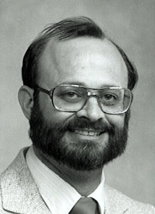 Jim Kahn calls out to promote 'generic' dancing – simple basic dances that actually look and feel as if they were done by the 'folk'. These 'classic' dances have the advantage that they are easily done by the beginning dancer, but have room within themselves for the subtlety of style and movement that gives internal satisfaction to the experienced dancer. By promoting, I mean that these dances should be a part of the beginner teaching series, reinforced by inclusion as a significant part of any evening's dance program.
Jim Kahn calls out to promote 'generic' dancing – simple basic dances that actually look and feel as if they were done by the 'folk'. These 'classic' dances have the advantage that they are easily done by the beginning dancer, but have room within themselves for the subtlety of style and movement that gives internal satisfaction to the experienced dancer. By promoting, I mean that these dances should be a part of the beginner teaching series, reinforced by inclusion as a significant part of any evening's dance program.
 Sanna Longden says it doesn't matter how hard we work to attract newcomers, keep regular dancers, and bring back old-timers if the dance evenings themselves are not fun. We try to make everyone happy, at least part of each night, by programming with an eye on the changing crowd, asking different people to lead, welcoming returning friends, remembering birthdays, encouraging those sitting out too long, and introducing out-of-towners. All this, of course, is in addition to pulling records and tapes, teaching and calling, even dancing. Fortunately, Mars and I enjoy this part of managing a group.
Sanna Longden says it doesn't matter how hard we work to attract newcomers, keep regular dancers, and bring back old-timers if the dance evenings themselves are not fun. We try to make everyone happy, at least part of each night, by programming with an eye on the changing crowd, asking different people to lead, welcoming returning friends, remembering birthdays, encouraging those sitting out too long, and introducing out-of-towners. All this, of course, is in addition to pulling records and tapes, teaching and calling, even dancing. Fortunately, Mars and I enjoy this part of managing a group.
Reaching out to others, having their comfort take priority, is essential if recreational folk dancing is to thrive. Our activity can no longer afford the luxury of leaders who are socially uncomfortable or who use their groups as personal power bases. Those who are not at ease with the human part of group management might designate some friendly people to be their social committee. This personal attention helps create the community feeling that is one of the main reasons to support recreational folk dancing.
See Sanna's article Let's Bring Folks Back to Recreational Folk Dance on this site!

 Mitch and Laurie Allen say that a prime task would be to focus on the media, attempt to place folk dance into the public consciousness, and generally inform the world as to what our activity has to offer. But that won't come without some changes in what we do. A monthly festival is nice, but not much of interest for the evening news. A big splash event would be different. Each year in Los Angeles there are several such events – Street Scene, Mask Festival, Cinco de Mayo celebrations – all of which entail a good deal of community involvement and which get substantial media coverage.
No activity survives without the people involved donating money heavily to its success. And there is the money to support the activity if we can mobilize it. The same dancers who object to paying $3.00 at a coffeehouse will often take $3,000.00 tours to Romania and Yugoslavia, or spend $300.00 on a summer folk dance camp. If only a small fraction of the money spent on folk dance related activities went into a development fund, there would be ample money down the road to help build folk dancing. Bequeathals could also be an important source of future stability.
Mitch and Laurie Allen say that a prime task would be to focus on the media, attempt to place folk dance into the public consciousness, and generally inform the world as to what our activity has to offer. But that won't come without some changes in what we do. A monthly festival is nice, but not much of interest for the evening news. A big splash event would be different. Each year in Los Angeles there are several such events – Street Scene, Mask Festival, Cinco de Mayo celebrations – all of which entail a good deal of community involvement and which get substantial media coverage.
No activity survives without the people involved donating money heavily to its success. And there is the money to support the activity if we can mobilize it. The same dancers who object to paying $3.00 at a coffeehouse will often take $3,000.00 tours to Romania and Yugoslavia, or spend $300.00 on a summer folk dance camp. If only a small fraction of the money spent on folk dance related activities went into a development fund, there would be ample money down the road to help build folk dancing. Bequeathals could also be an important source of future stability.
See the Allen's article Folk Dance Revival on this site!
 David Henry states that one way to nurture recreational International Folk Dance and folk music is to support the National Folk Organization. It has become a superlative network for folkdancers and musicians of every sort, and quite a few contributors to this site are already members.
David Henry states that one way to nurture recreational International Folk Dance and folk music is to support the National Folk Organization. It has become a superlative network for folkdancers and musicians of every sort, and quite a few contributors to this site are already members.
Let me assure everyone that this IS NOT a plea to dumb down our specialized groups so that everyone who walks in the door can participate – brain surgery isn't for everyone. Nor is it a plea to limit ourselves to little cutsie Balkan dances – how you gonna keep 'em down on the farm after they've seen Skopje! But let's face it, dancing a 20-minute Pravo or doing anything in the presence of Zournades is, like doing brain surgery, an acquired taste. That taste has been developed by many of us in generalist groups.
See David's article Folk Dance Demise on this site!
 Andrew Carnie says to avoid the words "folk dancing" at all costs. We use "international dance club." For some reason the term "folk dancing" has very negative associations for many people. One thing that seems to attract younger people is the possibliity of performance. If you tie participating in the recreational dancing to being an integral part of a performance troupe (but not vice versa, of course), it can really help. Couple and set dances tend to have fallen out of favor in most international folk dance (IFD) communities, but they really are a draw to the under-thirty crowd. Play the music two settings louder than you personally like it. It makes a big difference in the energy.
Andrew Carnie says to avoid the words "folk dancing" at all costs. We use "international dance club." For some reason the term "folk dancing" has very negative associations for many people. One thing that seems to attract younger people is the possibliity of performance. If you tie participating in the recreational dancing to being an integral part of a performance troupe (but not vice versa, of course), it can really help. Couple and set dances tend to have fallen out of favor in most international folk dance (IFD) communities, but they really are a draw to the under-thirty crowd. Play the music two settings louder than you personally like it. It makes a big difference in the energy.
See Andrew's article Attracting New Dancers on this site!
 Ron Houston concludes that neither the removal of the Iron Curtain and resultant stampede of professional ethnic dance "masters" to America nor the resurgence of ethnic identities around the world have revived folk dancing in the face of self-centered dancers, teachers, and organizations. Friends, even the literal resurrections of Gulick, Burchenal, and Beliajus wouldn't revive folk dancing! It's up to you, and you alone.
Ron Houston concludes that neither the removal of the Iron Curtain and resultant stampede of professional ethnic dance "masters" to America nor the resurgence of ethnic identities around the world have revived folk dancing in the face of self-centered dancers, teachers, and organizations. Friends, even the literal resurrections of Gulick, Burchenal, and Beliajus wouldn't revive folk dancing! It's up to you, and you alone.
See Ron's articles Chronology of International Folk Dancing and Reviving Folk Dance on this site!
 Loui Tucker wonders if we don't have doorways into our recreational International Folk Dance world, how can we expect to cultivate a new crop of dancers? I'm talking about dance classes designed specifically and exclusively for new dancers.
Loui Tucker wonders if we don't have doorways into our recreational International Folk Dance world, how can we expect to cultivate a new crop of dancers? I'm talking about dance classes designed specifically and exclusively for new dancers.
Teaching does not have to be a lifetime commitment. Find out if your local community center will let you teach an "Introduction to International Folk Dance" (or whatever fancy title you like) for 90 minutes a week for 8 weeks. Just 8 evenings out of your life could bring enthusiastic new dancers to our dance halls. See how it goes. If your class is a success and you enjoy doing it, then you can think about the long term.
Can you be a teacher for a new crop of beginning dancers? Can you set aside your passion for 5-part Bulgarian kopanicas for eight evenings, and instead channel your passion into teaching basic dances like Zemer Atik and Alunelul and Makedonka and Cumberland Square to some novices?
Some of the teachers teaching today were encouraged by their fellow dancers. "You're a good dancer and you'd be a great teacher! Why don't you start a class? If you do, we will come dance with you." If you can't take on the responsibility yourself, look around you and see if there is someone in your dance class who'd be a good candidate – and encourage THEM.
See Loui's article Advocating for More Couple Dancing and We Need a Commercial! on this site!
DON'T GIVE UP
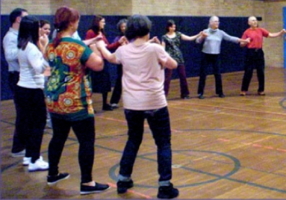 The IFDC of Toronto tells about one of the first ideas to be implemented was a Facebook page. They created an IFDC Meetup Group and an online social networking site that advertises many different groups of diverse interests, and encourages people to join a group's activities. The attendance has trended from what was averaging six to eight people per night in the previous winter and spring to upwards of twenty people, many of them new dancers of varying ages.
The IFDC of Toronto tells about one of the first ideas to be implemented was a Facebook page. They created an IFDC Meetup Group and an online social networking site that advertises many different groups of diverse interests, and encourages people to join a group's activities. The attendance has trended from what was averaging six to eight people per night in the previous winter and spring to upwards of twenty people, many of them new dancers of varying ages.
The advice of Loui Tucker, a United States teacher who's had success in rehabilitating folk dance groups and who shares her experience freely, is to use a multi-pronged approach and keep the efforts ongoing. They intend to follow her advice.
See the IFDC's article IFDC Challenges Declining Numbers on this site!
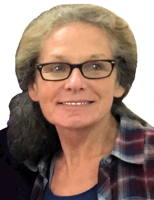 I enter our group in many different online listings, so, when it was suggested we join Meetup, I quickly set up a Meetup site before dashing off on a short ski vacation. When I returned, to my thrill and horror, I discovered we had 32 Meetup members, all new people! We were not prepared for this. To make things worse, because I had explicitly stated that people did not need to RSVP, our group did not know how many people to expect that night. Was it going to be 2 or 32? I alerted our group, we brought extra food, and hoped for the best. Only two new people showed up. The next week, much to our surprise, we had about eight new people, all beginners, so our teacher altered his teaching plans on the spot to accommodate them.
I enter our group in many different online listings, so, when it was suggested we join Meetup, I quickly set up a Meetup site before dashing off on a short ski vacation. When I returned, to my thrill and horror, I discovered we had 32 Meetup members, all new people! We were not prepared for this. To make things worse, because I had explicitly stated that people did not need to RSVP, our group did not know how many people to expect that night. Was it going to be 2 or 32? I alerted our group, we brought extra food, and hoped for the best. Only two new people showed up. The next week, much to our surprise, we had about eight new people, all beginners, so our teacher altered his teaching plans on the spot to accommodate them.
See Jan Rayman's article Meetup on this site!
 In 1994, Preston Ashbourne (Chair) and his "Revitalization Committee" (including Steve Davis, Richard Duree, Ted Martin, Richard Unciano, and Marvin Smith) produced a report on reviving of folk dancing for the Folk Dance Federation of California, South, Inc. It can have import for any folk dance organization or even folk dance groups.
In 1994, Preston Ashbourne (Chair) and his "Revitalization Committee" (including Steve Davis, Richard Duree, Ted Martin, Richard Unciano, and Marvin Smith) produced a report on reviving of folk dancing for the Folk Dance Federation of California, South, Inc. It can have import for any folk dance organization or even folk dance groups.
See Preston's article Revitalization Committee Report on this site!
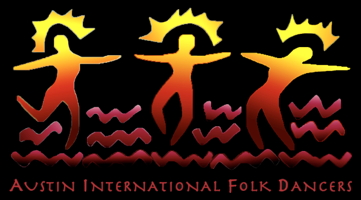 Austin International Folk Dancers membership dropped in the late 1960s from up to 100 dancers to 25 in 2007. In 2012, these are some of the things the group's board has suggested as a way to increase attendance:
Austin International Folk Dancers membership dropped in the late 1960s from up to 100 dancers to 25 in 2007. In 2012, these are some of the things the group's board has suggested as a way to increase attendance:
- Incorporate more sociable couple dances into the repertoire.
- Incorporate more live music into the dance evenings.
- Greet new attendees and visit with them.
- Encourage veteran dancers, especially "couch potatoes," to get up and dance.
- Encourage suitable experienced dancers to ask new women or men to dance.
- Help new dancers learn dances to accelerate their inclusion as regular members.
- Encourage newcomers to do the beginning and intermediate dances.
- Be a programmer and do dances that encourage participation.
- Have only one or two requests per dancer so that one person doesn't hog the list.
- Request dances to be played that most of the people present can do.
- Organize more non-dance activities such as after parties.
- Encourage new attendees to come to these events.
- Attend those events and build personal relationships with new attendees.
- Call persons who haven't been attending regularly to find out why.
- Ask what the group could do for non-attendees to resume attending regularly.
- Contact newcomers regularly and encourage them to come again.
- Plan special events around holidays or ethnicity or anything else.
- Have folk dance instruction from acknowledged local or imported instructors.
- Have live music by local folk dance musicians.
- Establish a monthly theme to highlight a particular ethnicity or country.
- Have specialty food parties, such as, chocolate, desserts, or an ethnic theme.
- Teach dances introduced in prior years at a Golden Oldies party.
- Be aware of how many people are not dancing and try to minimize that number.
- Have a list of "sure-fire winners" to play.
- If special guests are present, play a dance that they enjoy watching or dancing.
- Every dance played doesn't have to be on the request list.
- Be creative and include your own "requests" to maintain the energy level.
- Celebrate a holiday, anniversary, or other special day.
- Feature a theme, such as, a particular country or type of dance.
- Ensure that teaching of all easier dances focuses on basic steps.
- Be very selective on which dances are taught – do they reinforce the repertoire?
- Have dances taught for three consecutive weeks to ensure people learn it well.
- Ensure that dances taught are played for several weeks after teaching.
- Use "watch, then follow me" walkthroughs of 1 to 2 minutes with minimal question and answer period.
- Schedule the last meeting of the month as a non-teaching night and with a special theme to maximize dance time for everyone and to provide a break from teaching.
 Don't give up simply because folk dance attendance is down. It may pick up again if young folks tire of their other recreational, dance, and music outlets and find recreational international dancing once more. We need to develop our dance leaders even more than we develop our teachers. The recreational international dance leadership must consciously promote 'generic' dancing – simple basic dances that actually look and feel as if they were done by the folk – the classics. We need to start more beginners classes. Our future leaders are the ones who are going to be instrumental if there is to be a comeback of recreational International Dance.
Don't give up simply because folk dance attendance is down. It may pick up again if young folks tire of their other recreational, dance, and music outlets and find recreational international dancing once more. We need to develop our dance leaders even more than we develop our teachers. The recreational international dance leadership must consciously promote 'generic' dancing – simple basic dances that actually look and feel as if they were done by the folk – the classics. We need to start more beginners classes. Our future leaders are the ones who are going to be instrumental if there is to be a comeback of recreational International Dance.
–Dick Oakes
DOCUMENTS
- Attracting and Retaining New Folk Dancers, an article.
- Attracting New Dancers, an article.
- Chronology of International Folk Dancing, an article.
- Dick Oakes, an article.
- Folk Dance Demise, an article.
- Folk Dance Revival, an article.
- IFDC Challenges Declining Numbers, an article.
- Let's Bring Folks Back to Recreational Folk Dancing, an article.
- Reviving Folk Dance, an article.
- Revitalization Committee Report, an article.
- Three Kinds of Teachers: Which Shall We Follow?, an article.
- We Need a Commercial!, an article.
- Where Have All the Children Gone?, an article.
Used with permission of the author.
This page © 2018 by Ron Houston.
Please do not copy any part of this page without including this copyright notice.
Please do not copy small portions out of context.
Please do not copy large portions without permission from Ron Houston.
